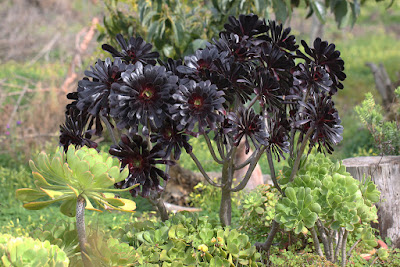Aeonium arboreum is native to the hillsides of the Canary Islands, where their natural range includes arid desert regions, it is known as bejeque arboreo and introduced in the Mediterranean...
Aeonium arboreum also called as The Tree Aeonium, Tree Houseleek, Irish Rose, Aeonium doramae, Aeonium doremae, Aeonium holochrysum, Aeonium manriqueorum, Aeonium rubrolineatum, Aeonium vestitum, Sempervivum arboretum, Sempervivum urbicum, is a species of the genus Aeonium. This species was described by Philip Barker Webb & Sabin Berthelot in 1840.
IDENTIFY AEONIUM ARBOREUM
Aeonium arboreum is native to the hillsides of the Canary Islands, where their natural range includes arid desert regions, it is known as bejeque arboreo and introduced in the Mediterranean.
The Tree Aeonium is a succulent, subtropical subshrub with lignified, branching, reaching 90 cm in height stem with rosettes of spoon-shaped shiny green, 5-8 cm long leaves which appears on the tops of branches.
Irish Rose blooms in late winter through early spring from the long flower spike appears from the center of the rosette with small, star-shaped, bisexual, bright yellow flowers.
AEONIUM ARBOREUM CARE AND CULTURE
Cultural information should only be used as a guide, and should be to be adapted to suit you. Your physical location; where you grow your plants, how much time you have to devote to their care, and many other factors, will need to be taken into account. Only then can you decide on the cultural methods that best suit you and your plants.
Light:
Aeonium arboreum needs full sun even in a period of rest, when there is no active growth. Due to insufficient lighting, the leaves will stretch and prematurely fall off, and the rosettes will be loose. It is not recommended to place this plant on the western windows.
Temperature:
This succulent grows well in warm temperature with 18-24 ° C, but it is not a tropical plant and it needs rest in winter, for which the plant is placed in a cool place. The optimum temperature in winter is about 10 ° C.
Substrate, growing media and repotting:
Aeonium arboreum is undemanding to the type of soil, but prefers a light, loose substrate with good drainage. It is possible to use a soil consisting of one part of coarse-grained sand or perlite and two parts of a standard soil mixture or of two parts of sand, one part of clay and one part of peat with the addition of fine gravel.
Since The Tree Aeonium grows rapidly, large specimens each year need to be transplanted into a pot one size larger. It is desirable to take the transplantation in the spring, when growth resumes. Ground around the roots of transplanted plants need to be compacted, the surface of the soil can be sprinkled with a thin layer of decorative stones.
Watering:
In nature, these plants fall into a hibernation in the summer, so in the summer time, watering should be infrequent, but abundantly, so that the entire soil layer is moist. Between waterings the soil must dry completely. In winter, watering is limited to about once a month. If watered less often, the leaves will start to wrinkle and curl, on the other hand, excessive watering will cause the leaves to grow weak and sluggish.
Fertilizer:
This succulent does not need a lot of fertilizers, it is enough two or three applications of liquid balanced fertilizer during the growing season.
Lifespan:
Aeonium arboreum is a monocarpic plant that dies after flowering. Full maturity of the plant reaches about 3-10 years, after which it blooms. Rosette after flowering perishes. Flowering can not be tolerated by trimming the emerging peduncles. In addition, the plant can be renewed from the apical cuttings or basal rosettes.
Diseases and pests:
The Tree Aeonium is sometimes affected by pests, such as aphids, mealybugs, scale insects and thrips. To deal with them, use a special insecticide soap or oil. However, use soap should be cautious, too frequent spraying with soapy water can lead to stains on the surface of the leaves.
If the soil is not sufficiently drained, the roots of the plant can rot. To prevent root rot, you need to use clay pots with good drainage, checking before planting, as the soil passes water. Roots should be in wet, not wet conditions.
At temperatures below 7 ° C, the tips of the leaves may freeze, which will cause the leaves to fall off. Direct sun rays and temperatures above 38 ° C can also damage and discard the foliage, especially if the soil is too dry.
Reproduction:
Aeonium arboreum are easy to propagate from tip cuttings. Cuttings are best done at the beginning of the growing season. It is necessary to carefully separate the rosette with a part of the stem 2-4 cm long, dab the end of the stem into the root hormone powder to stimulate root formation, and plant the stalk into a moistened mixture consisting of equal parts of peat and coarse sand or perlite. Cuttings put in a fairly bright and warm place and watered so that the soil was hardly damp. At a temperature of 18-24 ° C cuttings root for 2-3 weeks, after which they can be planted in pots with a soil mixture, which is used for adult plants. This succulent can also be propagated by seeds, but this is a slower way. Seeds are sown in spring at a temperature of 18-24 ° C.

















COMMENTS